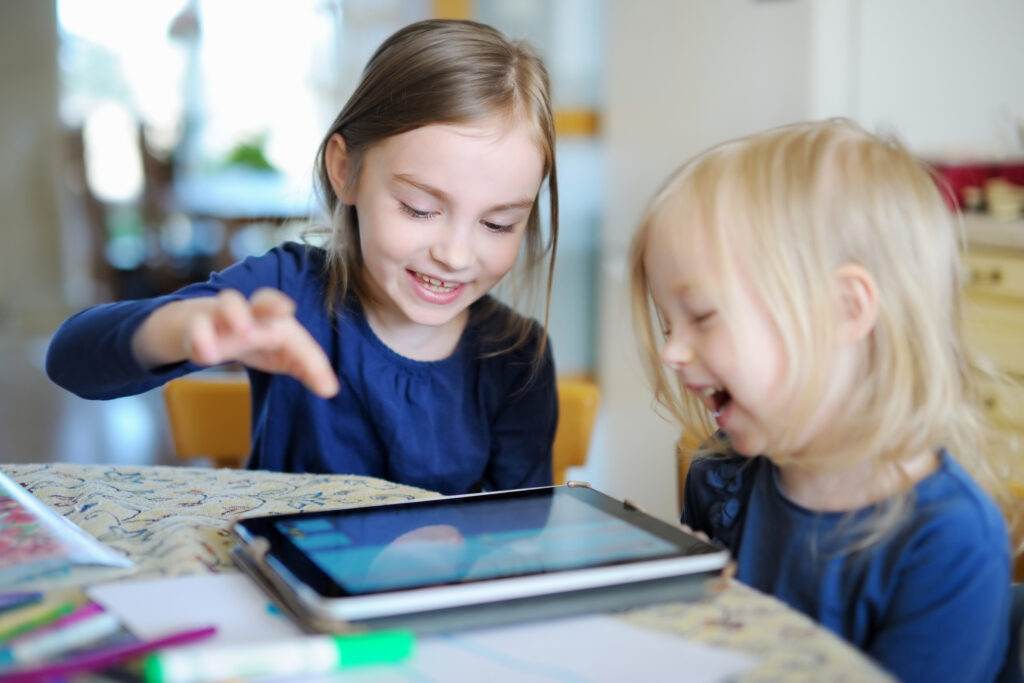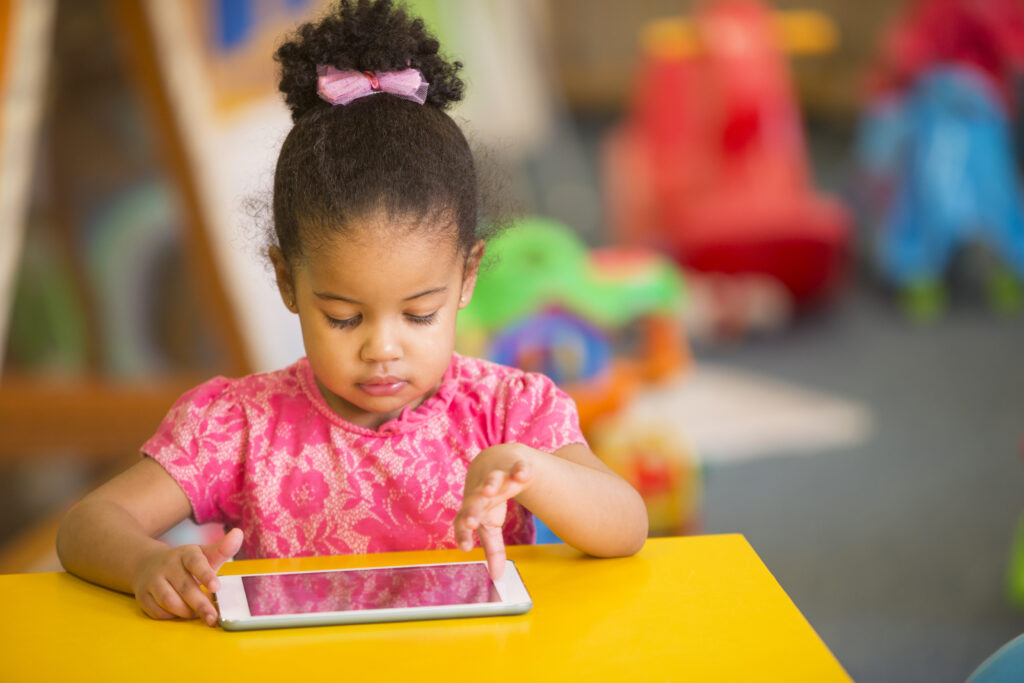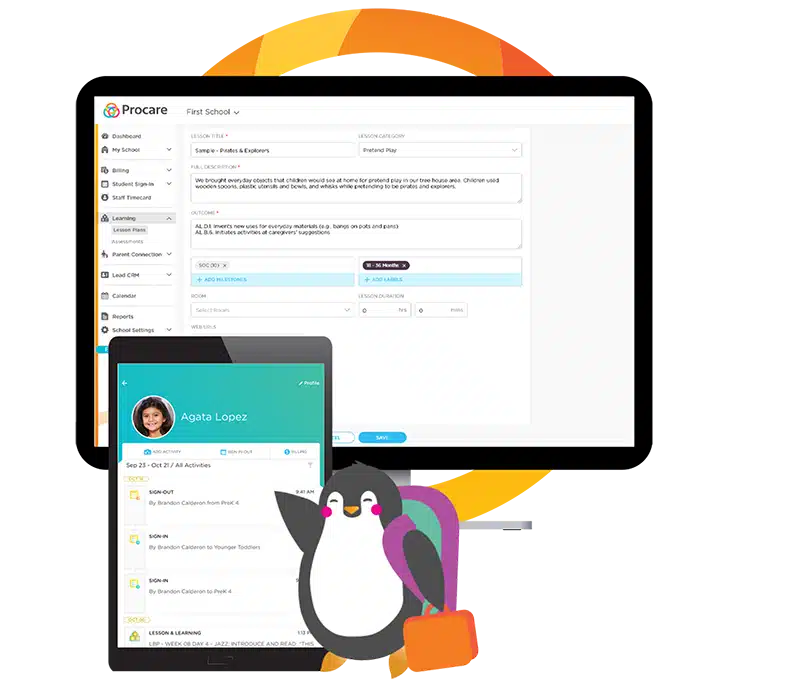
Incorporating technology into preschool classrooms can significantly enhance the learning experience for young children. Learning apps, when effectively integrated into the curriculum, can provide interactive opportunities for children to grasp foundational skills and concepts.
With the right approach, integrating technology in preschool classrooms can support learning and development. And by incorporating tech-based learning in a measured way, you can set the stage for success and lifelong learning.
Remember, it’s not about the technology itself, but how you use it.
Let’s take a deeper look into how a balanced and moderated use of technology in preschool classrooms can have positive impacts!
Benefits of Using Technology in the Preschool Classroom
Apps and software designed for young learners can turn difficult concepts into fun activities.
Bright colors, interactive challenges and instant feedback can capture the attention of preschoolers and keep them engaged longer! This can be particularly effective for children who might struggle to pay attention, or for those who are less inclined toward traditional learning activities.
And when implemented mindfully in a preschool setting, technology can foster collaboration among children. Whether working together on an interactive whiteboard or engaging in a group activity on a tablet, these experiences can teach children how to work and learn together.

The National Association for the Education of Young Children suggests allowing children “to freely explore touch screens loaded with a wide variety of developmentally appropriate interactive media experiences that are well designed and enhance feelings of success.”
The group also said to provide opportunities for children to begin to explore and feel comfortable using traditional mouse and keyboard computers, and to use websites or look up answers with a search engine.
Know the Limits of Using Technology
When technology is used to complement traditional teaching methods and hands-on activities, it enhances learning, engagement and development in young children.
A study by the American Academy of Pediatrics found there is “emerging evidence to suggest that interactive apps may be useful and accessible tools for supporting early academic development.” That group also suggests limiting digital media use for children 2 to 5 years to no more than one hour per day.
Design a daily routine that prioritizes varied activities including plenty of time for free play and outdoor activities to make sure screen time doesn’t dominate the day.
And remember that preschoolers need physical activity to build strong bones, muscle strength and motor skills!
Examples of Educational Apps for Preschoolers

Choosing the best apps to include in your child care center’s preschool rooms takes careful consideration. All early childhood apps should be tailored to the age group using them and for the skills the children are working on, such as math apps or early learning reading apps.
When choosing digital content for preschoolers, select educational programs that encourage participation and thought.
Let’s take a look at two apps to consider including in your preschool classrooms!
TeachMe
TeachMe combines interactive games and a comprehensive preschool curriculum with exciting rewards that keep kids motivated to learn. It covers topics including letters, ABC phonics, shapes, numbers, counting and colors.
As children progress, they earn virtual stickers that can be used to decorate six virtual scene. You can choose which topics you want to cover and choose specific questions, as well as review the performance history for each subject to check on how a child is doing.
Moose Math
This app is designed for children aged 3 to 7 and offers an engaging way for young learners to start developing their math skills such as counting, shapes, addition and subtraction, measurement and basic numbers.
Moose Math is aligned with Common Core state standards for Kindergarten and first grade and includes a report Card section where parents and teachers can monitor progress and find additional skill-building activities.
Moose Math features five math activities:
1. Moose Juice: Make smoothies while practicing counting, addition and subtraction
2. Paint pet: Match the pets by counting the number of dots
3. Pet Bingo: Solve addition, subtraction and counting problems to get bing
4. Lost and Found: Learn and sort through shapes and colors
5. Dot to Dot: Help the “Dust Funny” find his way home by joining the dots
How a Child Care App Can Help Your Center!

Using apps for early childhood education can be a good way to supplement the learning happening in your daycare or child care center. And using a child care mobile app can help you run your business, stay engaged with families and more!
With a fully integrated and complete parent engagement solution that also includes classroom management, the Procare child care mobile app allows families to be immersed in their children’s day-to-day activities – that includes tracking developmental milestones, sharing photos and videos as well as enabling two-way communication.
That’s because teachers can send photos and videos to parents with one tap! Parents can see their child’s activities that are shared from school and easily message staff.
They also can send reports on daily activities for infants and toddlers, as well as record activities such as diaper changes, bottle feedings and naps.
Centers can record custom student activities and attach development skills like fine motor, social behavior, language and more. And they can share newsletters in addition to upcoming events with parents easily through the calendar function.
The Procare child care mobile app allows families to make online payments and your center can create and send invoices to parents easily!
Check out this on-demand webinar to learn more about the app and see for yourself what it can do!


